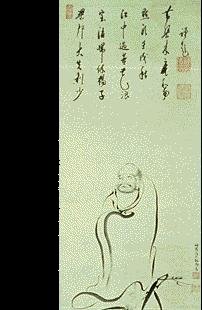
Since its initial habitents arrived sometime in the tenth century BC, Japan has had many different forms of art, thought the most preferred type is painting. This is because for most of their history the Japaneses used brushes to write their caligraphy like language.
Japan has had many different periods of art in its long history:
- Jomon and Yayoi art: The oldest period of Japanese art named after the first two types of people who settled in Japan. These people used clay to make statue and sculptures.
- Kofun art: As with the previous period this period mostly used clay sculpture for art.
- Asuka and Nara art: This period featured the first incorperation of Chinese art into the Japanese style. This would happen many more times in the course of Japanese history.
- Heian art: Early examples of Yamato-e style paintings are created. These are paintings on the wooden doors of buildings.
Also the emaki, illustrated hand scrolls come into being. The 'Tale of Genji' from 1130 is the most famous of these scrolls.
- Kamakura art: (The Kegon era) Emaki combines passages of text with pictures for the illitarate population of Japan, creating a kind of comic strip.
- Muromachi art: This is another period during which Chinese paintings greatly influenced Japanese artists.
The Muromachi paintings are easily recognised by their minimum of detail, created with a few quick brush strokes.
- Momoya art: This period features the beginings of monumental landscapes painted on the sliding doors or the rooms of temples and houses.
- Edo period: This period started the best know style of Japanese art, wood block prints or 'ukiyo-e' paintings. These began to be produced in the late 17th century and soon they evoved into the polychrome prints seen today.
Also from this period comes the Bunjuga, a style much like that of the Chinese artists.
Japan has since developped two main forms of art: Yoga (western-style paintings) and Nihonga (traditional Japanese paintings). These two styles are both widely known, both throughout Japan and the world.
(Microsoft Encarta Encyclopedia 99)

Japanese artist Sesshû, who was also a Zen Buddhist priest, painted Falcons and Herons in the 15th century. He is one of the most important artists of the Muromachi period. He was influenced by the chineses use of monochromatic coloring, which is used in this picture. (Microsoft Encarta Encyclopedia 99)
 This scroll is an example of Japanese calligraphy. Calligraphy is generally considered a form of lettering in the western world, it is also a drawing style used in Japan. The lettering and the figure are drawn in ink using a brush, while the rectangular forms are made with stamps, using red ink.
This scroll is an example of Japanese calligraphy. Calligraphy is generally considered a form of lettering in the western world, it is also a drawing style used in Japan. The lettering and the figure are drawn in ink using a brush, while the rectangular forms are made with stamps, using red ink.
"Sesshu's Falcons and Herons," Microsoft® Encarta® Encyclopedia 99. © 1993-1998 Microsoft Corporation. All rights reserved.
"Japanese Calligraphy," Microsoft® Encarta® Encyclopedia 99. © 1993-1998 Microsoft Corporation. All rights reserved.
BACK


 This scroll is an example of Japanese calligraphy. Calligraphy is generally considered a form of lettering in the western world, it is also a drawing style used in Japan. The lettering and the figure are drawn in ink using a brush, while the rectangular forms are made with stamps, using red ink.
This scroll is an example of Japanese calligraphy. Calligraphy is generally considered a form of lettering in the western world, it is also a drawing style used in Japan. The lettering and the figure are drawn in ink using a brush, while the rectangular forms are made with stamps, using red ink.